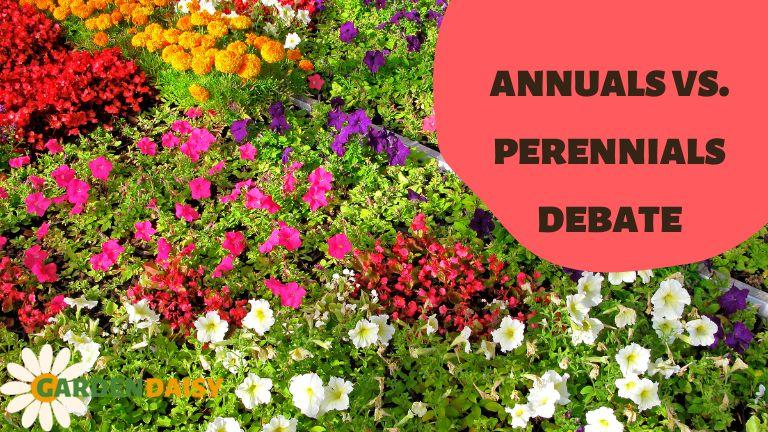Should You Plant Annuals Or Perennials? A Practical Comparison

Table of Contents
Understanding Annuals and Perennials
What are Annuals?
Annual flowers complete their entire life cycle – from germination to seed production – within a single growing season. This means they sprout, bloom, produce seeds, and die all within one year.
-
Characteristics: Annuals are celebrated for their bright, vibrant blooms and the sheer diversity of colors and types available. They are perfect for creating dramatic and eye-catching displays in flowerbeds, containers, and hanging baskets. However, this vibrant beauty often comes at the cost of needing to be replanted every year.
-
Examples: Popular annuals include petunias (known for their abundant blooms), zinnias (with their cheerful daisy-like flowers), marigolds (adding a splash of sunny yellow or orange), and sunflowers (towering giants perfect for a bold statement).
-
Pros:
- Wide variety of colors, sizes, and flower shapes.
- Quick and easy to establish, providing instant gratification.
- Excellent for creating temporary displays and themed gardens.
- Perfect for filling gaps in perennial borders.
-
Cons:
- Need to be replanted annually, which can be time-consuming and expensive.
- More frequent watering and fertilization may be required for optimal growth.
What are Perennials?
Perennial plants, unlike annuals, live for more than two years, returning year after year. They may die back to the ground in winter in colder climates but will regrow from their roots in the spring.
-
Characteristics: Perennials often have a longer lifespan, offering a more established and natural look to your garden. While their blooming periods may be shorter than those of annuals, their continuous presence contributes to a consistent garden landscape. They may require more initial care to establish a strong root system.
-
Examples: Popular perennials include daylilies (known for their prolific blooms), hostas (providing beautiful foliage), lavender (with its fragrant flowers and calming scent), and coneflowers (attracting pollinators with their daisy-like appearance).
-
Pros:
- Cost-effective in the long run as you don't need to replant them every year.
- Less frequent planting and replanting saves time and effort.
- Contribute to a more established and mature garden look.
- Many perennials offer attractive foliage even when not in bloom.
-
Cons:
- Slower to establish than annuals; it may take a year or two to see their full potential.
- May require more maintenance initially, such as regular watering and weeding, to help them establish strong roots.
- Bloom times are generally shorter than those of annuals.
Comparing Annuals and Perennials: A Head-to-Head Look
Cost
Annuals have higher upfront costs due to the need for annual replacement. However, the long-term cost can be lower if you grow your own plants from seed. Perennials have lower upfront costs but may require more initial investment in terms of soil preparation and plant establishment.
Maintenance
Annuals generally require more frequent maintenance, including regular watering, fertilizing, and deadheading (removing spent flowers to encourage more blooms). Perennials, once established, require less frequent maintenance but may need dividing every few years to prevent overcrowding or pruning to maintain their shape.
Bloom Time
Annuals typically offer a longer continuous bloom season within their single growing season. Perennials, on the other hand, boast shorter bloom periods, but these blooms are spread over several years, providing a succession of color throughout the growing seasons.
Garden Design Considerations
Annuals provide flexibility; you can easily change your garden's look and feel each year by planting different varieties. Perennials offer a more stable and established design, creating a consistent and predictable landscape year after year.
Choosing the Right Plant for Your Needs
Beginner Gardeners
Annuals are often a better starting point for beginner gardeners. Their quick results and shorter commitment period provide a less daunting introduction to the world of gardening. The immediate visual reward can be very motivating.
Experienced Gardeners
Experienced gardeners often appreciate the long-term commitment and design opportunities offered by perennials. The layered effect and gradual development of a perennial garden can be very satisfying.
Climate Considerations
Both annuals and perennials have varying degrees of hardiness, meaning some thrive in certain climates better than others. Choose plants that are suited to your specific USDA Plant Hardiness Zone to ensure success.
Conclusion
The choice between annuals and perennials is a personal one, depending on your individual gardening experience, budget, and aesthetic preferences. Annuals deliver vibrant bursts of color and instant gratification, while perennials offer enduring beauty and a more established garden over time. By weighing the pros and cons of each, you can make an informed decision that complements your gardening style and creates the garden of your dreams. So, start planning your garden today – whether you choose the vibrant display of annuals or the enduring charm of perennials, your garden awaits!

Featured Posts
-
 Pokemon Tcg Pocket Codes How To Find And Redeem Them
May 29, 2025
Pokemon Tcg Pocket Codes How To Find And Redeem Them
May 29, 2025 -
 Van Der Gijp Twijfelt Opvolger Farioli Onwaarschijnlijk
May 29, 2025
Van Der Gijp Twijfelt Opvolger Farioli Onwaarschijnlijk
May 29, 2025 -
 New Pokemon Tcg Pocket Event Five Exclusive Promo Cards Revealed
May 29, 2025
New Pokemon Tcg Pocket Event Five Exclusive Promo Cards Revealed
May 29, 2025 -
 Trade War Impact Canadian Aluminum Trader Files For Bankruptcy
May 29, 2025
Trade War Impact Canadian Aluminum Trader Files For Bankruptcy
May 29, 2025 -
 Mogelijke Farioli Opvolger In Gesprek Met Knvb Over Contract
May 29, 2025
Mogelijke Farioli Opvolger In Gesprek Met Knvb Over Contract
May 29, 2025
Latest Posts
-
 Urgent Foreign Office Travel Advice Greece Safety Concerns For Uk Citizens
May 30, 2025
Urgent Foreign Office Travel Advice Greece Safety Concerns For Uk Citizens
May 30, 2025 -
 British Travellers In Greece Four Key Issues And Foreign Office Alert
May 30, 2025
British Travellers In Greece Four Key Issues And Foreign Office Alert
May 30, 2025 -
 Greece Travel Warning Urgent Advice For British Tourists
May 30, 2025
Greece Travel Warning Urgent Advice For British Tourists
May 30, 2025 -
 Heatwave Mortality In England 311 Deaths Prompt Call For Improved Preparedness
May 30, 2025
Heatwave Mortality In England 311 Deaths Prompt Call For Improved Preparedness
May 30, 2025 -
 Rising Temperatures Rising Deaths 311 Fatalities In Englands Heatwave
May 30, 2025
Rising Temperatures Rising Deaths 311 Fatalities In Englands Heatwave
May 30, 2025
